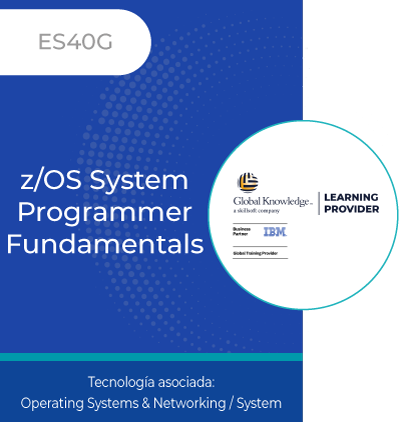ES40G | z/OS System Programmer Fundamentals
This course is designed to describe the basic components that apply to all z/OS systems. It includes high level concepts that apply to the z/OS hardware platform and the z/OS software. It then provides a more detailed analysis, description and lab activities that can be applied to the system programmer role to maintain z/OS systems. Discussion activities include: The POR, IPL process, JES implementation and operating environment, VTAM environment for TSO, ISPF, SNA and TCP/IP networking, RACF, ISPF/PDF and UNIX System Services. It defines the classic approach to data management in a z/OS system. It identifies various software products and utilities used to define, maintain, and manage catalogs and data sets in the z/OS environment. It also discusses Parmlib usage and requirements for system initialization and operation that include: System symbolics, WLM, SFM, RMF and system logger. Both single system and multi-system sysplex usage is identified. z/OS install, upgrade options, maintenance using SMP/E and I/O configuration requirements using HCD is listed and described.
Objetivos del curso
- Describe the basics of z/OS architecture
- Identify basic components of a z/OS system
- Discuss what you have learned about LPARs
- Describe maintenance principles
- Identify and list the POR process
- Describe the IPL process
- Identify the basic address spaces
- Describe how to shut down z/OS
- Implement a basic JES2 batch environment
- Identify how work can be started in z/OS and it's relationship to the job entry subsystem
- Describe how JES2 prepares and executes work in z/OS
- Explain JES2 start options
- Describe JES2 parameters that can be customized to support z/OS batch
- Identify how communications and control of JES2 can be done using the operator commands and SDSF
- Describe JES3 configuration and job processing phases
- Identify JES3 start options
- Describe the two networking schemes in the z/OS environment: SNA and IP
- Identify SNA networking resources
- Explain how SNA sessions are established
- Describe the role of TCP/IP as a physical filesystem in UNIX System Services
- Implement and start a local VTAM instance to provide the base for SNA applications such as TSO
- Implement and start TSO
- Start a TCPIP stack and check accompanying messages
- Identify the main functions of Security Server (RACF) and the role it plays in controlling user access to the system
- Describe the contents of RACF user, group, and resource profiles
- Describe how RACF profiles are used to authorize user access to a data set resource
- Identify two key members used for TCAS startup
- Name the components of ISPF
- Describe the general layout of ISPF/PDF panels
- Describe how UNIX System Services are used in z/OS
- Describe briefly the UNIX Shell and utilities and how they are accessed
- Describe the application services provided in UNIX System Services
- Describe how security is handled in UNIX System Services
- Describe the classical z/OS data management
- DASD init: VTOC, VTOC index
- ICF catalog creation: BCS, VVDS
- MCAT/UCAT
- IDCAMS utility
- DFSMS: DFSMSdss, DFSMShsm
- Data, storage, and management classes
- Define the hierarchical data management
- HFS file system
- zFS file system
- Define load-parameters for IPL
- Define symbols for use in system initialization
- Define a configuration for system initialization
- Define a library for procedures
- Identify the sysplex resources required to run WLM
- List the main components that comprise a WLM service definition for a system/sysplex
- Describe the function of WLM service definition parameters such as workloads, service goals, periods, and WLM subsystems
- Describe how SMF data set are created and used
- Explain SMF record types and how they are used
- Identify the three RMF monitor types
- Describe how the RMF monitor is used for reporting purposes
- Identify System Logger components and usage for:
- Sysplex configuration and CF logstreams
- Single system and DASD-only logstreams
- Describe SMF usage of logstreams
- Describe the differences between IOCDS and IODF
- Identify and list the HCD definition process sequence
- Describe how the HCD dialogs are used to define a configuration
- Discuss the purpose of Hardware Configuration Manager
- Describe the overall concept of SMP/E: Global, target and DLIB zones
- Describe what elements and SYSMODs are
- Create an SMP/E working environment
- Identify the batch and ISPF interfaces to SMP/E
- Install a user function using RECEIVE, APPLY, and ACCEPT
- Explain how to remove a SYSMOD with RESTORE
- Describe the installation options available to install z/OS
- Use the attributes of z/OS elements and features to identify the contents of a z/OS product
- Describe the contents of the ServerPac offering and important install documentation sources
- List the main steps in the ServerPac build process
- Describe hardware and software prerequisites for performing a ServerPac installation in:
- The driving system
- The target system
Audience
This intermediate class is intended for new System Programmers and System Administrators, who require an overall understanding of the z/OS platform, z/OS components, data management, and installation and maintenance activities used in z/OS systems.
Prerequisites
You should:
- Have z/OS installation experience or have attended z/OS Installation (ES41A)
- Be familiar with end user activities on MVS, including knowledge of JCL, IDCAMS, the MVS address space structure, and the concept of batch scheduling using JES initiators
Descargue el temario para conocer el detalle completo de los contenidos.
Debido a las constantes actualizaciones de los contenidos de los cursos por parte del fabricante, el contenido de este temario puede variar con respecto al publicado en el sitio oficial, sin embargo, Netec siempre entregará la versión actualizada de éste.
ES40G | z/OS System Programmer Fundamentals
Duración 4 días Versión 1 Temario Descarga aquí ⇩ Fechas IBM Consultar Métodos de entrega 👤 💻

